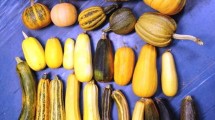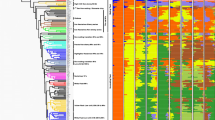Abstract
Allozyme variation was examined in three pejibaye (Bactris gasipaes) populations introduced into Hawaii for use in heart-of-palm improvement: Benjamin Constant (Putumayo landrace), San Carlos (Guatuso landrace) and Yurimaguas (Pampa Hermosa landrace). Nine enzymes encoded by 16 putative loci with a total of 38 alleles were resolved from meristem extract. Five loci were fixed in all populations, four additional loci were fixed in SC and one additional locus in BC. Six of the 38 alleles were rare, with three unique to BC and one to Y; two moderately high frequency alleles were unique to SC. Mean number of alleles per locus was lowest (1.6) in SC, with BC and Y having 2.1 alleles. Percentage of polymorphic loci was lowest in SC (44) and highest in Y (69). Observed heterozygosity was lowest in SC (0.051) and BC (0.066) and highest in Y (0.141). Nei’s genetic identity was 0.985 between BC and Y and averaged 0.952 between SC and BC-Y. The low heterozygosities are probably due to a long history of selection and inbreeding (sib-mating) during the domestication process, followed by intensive recent selection for spinelessness and more inbreeding. All populations are very closely related, suggesting a single domestication event in Amazonia.
Résumé
A variaÇÇo isoenzimÇtica foi examinada em três populaêêes de pupunha (Bactris gasipaes) introduzidas no Havai para usar no melhoramento genético da esécie para a produééo de palmito fresco: Benjamin Constant (raÇa Putumayo), San Carlos (raÇa Guatuso) e Yurimaguas (raÇa Pampa Hermosa). Nove enzimas codificadas por 16 loci com um total de 38 alelos foram obtidas de um extrato meristemático. Cinco loci foram fixados em todas as populaááes, quatro outros loci foram encontrados somente em BC e um outro em Y; dois alelos com frequências moderadamente altas foram encontrados somente em SC. O número múdio de alelos por locus foi menor em SC (1,6), com BC e Y apresentando 2,1 alelos por locus. A porcentagem de loci polimórficos foi menor em SC (44) e maior em Y (69). A heterozigosidade observada foi menor em SC (0.051) e BC (0.066), e maior em Y (0.141). A identidade genética de Nei foi 0.985 entre BC e Y, e apresentou uma média de 0.952 entre SC e BC-Y. As heterozigosidades baixas séo provavelmente devidas a uma longa história de selegao e endocruzamento (entre irmóos) dur-ante o processo de domesticaÇão, seguido recentemente por seleÇÇo intensiva contra espinhos e mais endocruzamentos. As três populaêêes sêo muito aparentadas, sugerindo um ênico evento de domesticaão na Amazãnia.
Similar content being viewed by others
Literature cited
Bennaceur, M., C. Lanaud, M. H. Chevallier, and N. Bounaga. 1991. Genetic diversity of the date palm (Phoenix dactylifera L.) from Algeria revealed by enzyme markers. Plant Breeding 107:56–69.
Clement, C. R. 1986. Descriptores mínimos para el pejibaye (Bactris gasipaes H.B.K.) y sus implica-ciones filogeníticas. M.Sc. Thesis, Universidad de Costa Rica, San Josí, Costa Rica.
—. 1988. Domestication of the pejibaye palm (Bactris gasipaes): Past and present. Pages 155–174in M. J. Balick, ed., The palm—Tree of life. Advances in Economic Botany 6. New York Botanical Garden, New York, NY.
—. 1992. Domesticated palms. Principes 36:70–78.
—. 1995. Growth and genetic analysis of pejibaye (Bactris gasipaes Kunth, Palmae) in Hawaii. Ph.D. Dissertation, University of Hawaii at Manoa, Honolulu, HI.
Clement, C. R., W. B. Chavez F., and J. B. Moreira Gomes. 1988. ConsideraÇÇes sobre a pupunha (Bactris gasipaes H.B.K.) como produtora de pal-mito. Pages 225–247in Anais do Primeiro Encon-tro Nacional de Pesquisadores em Palmito. Centra Nacional de Pesquisas Florestais, Curitiba, ParanÇ, Brazil.
Clement, C. R., and J. E. Mora Urpi. 1987. Pejibaye palm (Bactris gasipaes, Arecaceae): multi-use potential for the lowland humid tropics. Economic Botany 41:302–311.
Dixon, M., and E. C. Webb. 1964. Enzymes. 2nd ed. Academic Press, New York, NY.
Doebley, J. 1989. Isozymic evidence and the evolution of crop plants. Pages 165–191in D. E. Soltis, and P. S. Soltis, eds., Isozymes in plant biology. Dioscorides Press, Portland, OR.
Doebley, J. F., M. M. Goodman, and C. W. Stuber. 1985. Isozyme variation in the races of maize from Mexico. American Journal of Botany 72:629–639.
Ghesquiere, M. 1984. Polymorphisme enzymatique chez le palmier a huile (Elaeis guineensis Jacq.). I. Contrôle gônetique de neuf systômes enzymatiques. Oleagineux 39:561–574.
—. 1985. Polymorphisme enzymatique chez le palmier a huile(Elaeis guineensis Jacq.). II. Var- iabilite et structure genetique de sept origines de palmiers. Oleagineux 40:529–540.
Ghesquiere, M., E. Barcelos, M. M. Santos, andP. Amblard 1987. Polymorphisme enzymatique chezElaeis oleifera H.B.K. (E. melanococca). Analyse des populations du Bassin amazonien. Oléagineux 42:143–154.
Hedrick, P. W. 1985. Genetics of populations. Jones and Bartlett, Boston, MA.
Lebot, V., and K. M. Aradhya. 1991. Isozyme variation in taro (Colocasia esculenta (L.) Schott) from Asia and Oceania. Euphytica 56:55–66.
McLeod, M. J., S. I. Guttman, W. H. Esbaugh, and R. E. Rayle. 1983. An electrophoretic study of evolution inCapsicum (Solanaceae). Evolution 37: 562–574.
Mora Urpí, J. 1992. Pejibaye (Bactris gasipaes). Pages 209–220in J. E. Herníndez Bermejo, and J. Leín, eds., Cultivos marginados: otra perspectiva de 1492. Food and Agriculture OrganizationíFAO/Jardin Botínico de Círdoba (Espaía), Rome.
Mora Urpí, J., and C. R. Clement. 1988. Races and populations of peach palm found in the Amazon basin. Pages 78–94in C. R. Clement, and L. Carotene, eds., Final report (revised): Peach palm (Bactris gasipaes H.B.K.) germplasm bank. Insti-tuto Nacional de Pesquisas da Amazínia/Centro Nacional de Recursos Geníticos, Manaus, Ama-zonas, Brazil.
Nei, M. 1975. Molecular population genetics and evolution. North Holland, Amsterdam.
Rojas Vargas, S. M. 1993. Establecimiento de una tecnica para el análisis isoenzimático de pejibaye (Bactris gasipaes Kunth). M.S. Thesis, Universidad de Costa Rica, San Josá, Costa Rica.
Shaw, C. R., and R. Prasad. 1970. Starch gel elec-trophoresis of enzymes—A compilation of recipes. Biochemical Genetics 4:297–320.
Spiegel-Roy, P. 1986. Domestication of fruit trees. Pages 201–211in C. Barigozzi, ed., The origin and domestication of cultivated plants. Elsevier, Amsterdam.
Stuber, C. W. 1991. Isozyme markers and their significance in crop improvement. Pages 59–68in K. R. Khanna, ed., Biochemical aspects of crop improvement. CRC Press, Boca Raton, FL.
Swofford, D. L., and R. B. Selander. 1989. BioSys 1.7 user’s manual. Illinois Natural History Survey, Urbana, IL.
Torres, A. M. 1989. Isozyme analysis of tree fruits. Pages 192–205in D. E. Soltis, and P. S. Soltis, eds., Isozymes in plant biology. Dioscorides Press, Portland, OR.
Uhl, N. W., and J. Dransfield. 1987. Genera pal-marum. Allan Press, Lawrence, KA.
Weeden, N. F., and J. F. Wendel. 1989. Genetics of plant isozymes. Pages 46–75in D. E. Soltis, and P. S. Soltis, eds., Isozymes in plant biology. Dioscor-ides Press, Portland, OR.
Wendel, J. F., and N. F. Weeden. 1989. Visualization and interpretation of plant isozymes. Pages 5–45in D. E. Soltis, and P. S. Soltis, eds., Isozymes in plant biology. Dioscorides Press, Portland, OR.
Wright, S. 1978. Evolution and the genetics of populations. 4. Variability within and among natural populations. Univ. Chicago, Chicago, IL.
Author information
Authors and Affiliations
Rights and permissions
About this article
Cite this article
Clement, C.R., Aradhya, M.K. & Manshardt, R.M. Allozyme Variation In Spineless Pejibaye (bactris Gasipaes Palmae). Econ Bot 51, 149–157 (1997). https://doi.org/10.1007/BF02893108
Received:
Accepted:
Issue Date:
DOI: https://doi.org/10.1007/BF02893108




